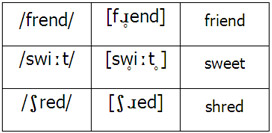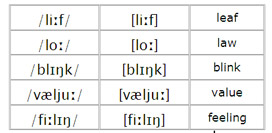The transcriptions we have considered so far were phonemic transcriptions, (also used synonymously with broad transcriptions) which contain the minimum amount of phonetic detail needed in order to be able to distinguish between words.
A narrow transcription contains phonetic detail which can often be predicted by ‘rules’.
Today, we will discuss some of the main “rules” for converting a broad transcription to a narrow transcription.
Remember that any narrow, ie. phonetic, transcription must be enclosed in [ ] brackets.
“Rules” for Narrow Transcription
You need to understand clearly that the guidelines to narrow transcription provided below are not really “rules” but more of predictions.
That is, the uncritical application of these guidelines will not always result in a perfect narrow transcription.
Speakers are at liberty to modify their pronunciations in various ways.
Speakers differ from each other in their precise pronunciation and the same speaker may vary the pronunciation of the same word in different contexts.
Guidelines for transcription are therefore probabilistic in nature in that they suggest the most likely pronunciations.
It is up to you to carefully listen to the actual recordings when doing your transcriptions and to record each speaker’s actual pronunciation (especially in the assignment).
Narrow Transcription of /r/
It has been a long convention in English phonetics and phonology for the phoneme /r/ to be represented by the symbol “r”.
This has simplified the symbolic representation of this phoneme which can be realized in a number of different ways in various English dialects (alveolar, post-alveolar and retroflex approximants are the most common, but alveolar trills and taps as well as uvular trills also occur in some dialects).
In General English this phoneme is usually realized as an alveolar or a post-alveolar approximant.
Therefore, the first thing that you should do when converting a broad transcription of general English to a narrow transcription, is to convert all instances of /r/ to 
Aspiration and release of oral stops
(i) Aspiration
Voiceless oral stops are aspirated before stressed vowels/diphthongs in the same syllable.
e.g.

The aspiration rule does not apply when voiceless oral stops follow /s/ (in the same syllable).
e.g.

(ii) Syllable and word-final (VC) oral stops
What we have discussed so far, are on oral stop aspiration and release, concentrating on initial or CV stops.
Word and syllable-final oral stops or VC stops show somewhat different patterns of release to those shown by CV stops.
When carrying out a narrow transcription of VC stops we are particularly interested in whether the release of the stop is audible or inaudible.
This applies to both voiced and voiceless stops.
It is customary, when transcribing English to leave audibly released stops unmarked (ie. [p], [b], [t], [d], [k], [g]) and to indicate stops without audible release as: 
Here are some examples of pairs of words with and without audible release:

Devoicing
(i) Devoicing Voiced Oral Stops and Fricatives
Voiced oral stops and voiced fricatives are usually devoiced in the following contexts:
a) Before a pause (eg. at the end of a sentence or utterance):

b) Before a voiceless or devoiced obstruent (ie. before oral stops, affricates or fricatives)

(ii) Devoicing Approximants Following Voiceless Fricatives
When approximants immediately follow voiceless fricatives they are often, but not always, devoiced.
Note that this devoicing doesn’t always happen.
It usually happens when the fricative and approximant are in the same syllable.
It also seems to be more likely to happen when the syllable is stressed.

Clear and Dark realizations of /l/
i) Before pure vowels, diphthongs and /j/, /l/ is realized as [l] (clear ‘l’).

ii) Before consonants (except /j/) or a pause (eg. the end of a sentence or utterance), the allophone is dark (velarized)

Dark l is also usually found at the end of a word even when the following word starts with a vowel.
This articulation clearly marks the /l/ as belonging to the end of the first word rather than the beginning of the second word.

Assimilation of alveolars
The following assimilations should be noted.
Alveolar assimilation is extremely common, but exceptions to these rules do occur, even in casual connected speech.
Assimilations are much less likely to occur in careful speech and particularly when articulating isolated words carefully.
i) Labiodental nasals before labiodentals

ii) Dental nasal and oral stops before dentals

Syllabic consonants
All syllabic consonants must be marked with a diacritic (as shown in the examples below) in narrow transcription.

Nasalization
Nasalization is particularly likely to occur when a low vowel such as  occurs next to a nasal consonant.
occurs next to a nasal consonant.
Nasalization can occur for any vowel adjacent to a nasal consonant but it tends to be stronger and more audible for low vowels.


thanks for these explicit explanation but i would like more execises please
These are lecture notes, but I shall try and post some exercises soon. Thanks for the idea Sanaa 🙂
Hi! I was surfing and found your blog post… nice! I love your blog. 🙂 Cheers! Sandra. R.
Thanks for this, it’s so helpful to have all these “rules” in one place!
its good bt where can i find sufficient phonetic transcription
sufficient for what? what exactly is it that you need?
Thank you for providing these notes – very useful indeed!
Thanks for sharing this useful information. 🙂
thank u..I have a test about this, and it’s great!! thanks again..
I really thank you for these considerable and well done explanations,,,I have consulted plenty of sites to seek some information about a detailed phonetic transcription with all the components of the IPA and you are the first to give this complete work ,,,I am grateful , I have an important exam next week in this subject and I would like to have some exercises with corrections to train as far as the narrow transcription is concerned.
Your explanations are very good!
The best thing about phonetics in WEB.
But I’d like to know something about pre-fortis clipping, can you help me?
thanks a lot for your notes to be honnest i appreciate you
Thanks…It’s actually elaborated on next page,,,really great work….
Thanks for sharing such nice notes with us….
Regards
Noor. Lect.Eng
So helpful to me and very clear – thank you!